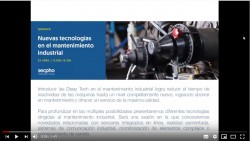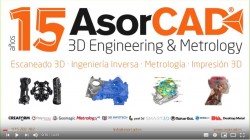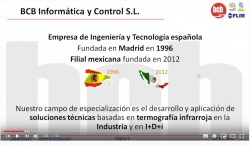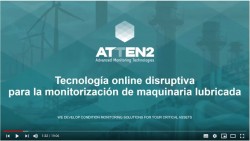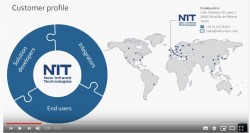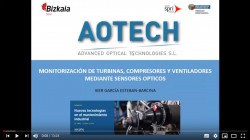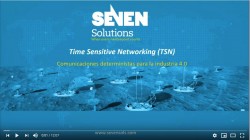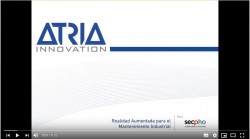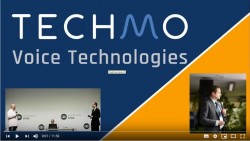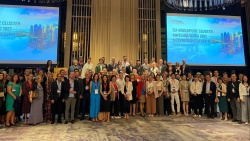In the webinar “New technologies in industrial maintenance” held on April 2nd, attendees learned about different technologies that can help reduce machine downtime, save on maintenance and offer the highest quality service. All the presentations where held in spanish, here you can find an overview with links to the videos.
Antonio Sanchez, CEO of AsorCAD Engineering started the session with the speech “3D technologies optimize industrial maintenance“ and explained how they use optical scanning technologies to do reverse engineering and in industrial maintenance. With 3D printing, parts can be created from sketches or the data obtained by 3D scanning can be repaired. In addition, he explained that with the combination of 3D metrology it is possible to verify the wear and tear on parts.
Victor Manuel Blanco, Business Development Manager of BCB explained in the lecture “Applications of infrared thermography to preventive maintenance” the advantages of thermographic monitoring:
- Non-contact measurement
- Remote monitoring from a secure location
- With a few cameras, a large area can be covered
- Communication with Ethernet and fiber optics, which minimizes noise problems
- Temperature readings that allow for the prediction of potential molten metal leaks
- Even earlier detection, if trend analysis software is used
- Refrigerated housings available for steelworks
And among the applications of infrared thermography, its applications by sector stand out. In the steel industry, it is possible to monitor the casting, the composition of the ladle and even the electrodes in the Arc Furnaces. In the case of the automotive industry, critical equipment can be monitored, as well as the thermal distribution in the furnaces.
On the other hand, Eneko Gorritxategi, CTO of Atten2 presented the value proposal of this spinoff from Tekniker, which is oriented to monitor critical lubricated machinery. In his presentation “Tecnología online disruptiva para la monitorización de maquinaria lubricada” he explained that in industrial digitalization, the use of sensors is key and is where most progress is being made. In the case of Atten2, the sensors analyse the oil to diagnose the state of the machine. “It’s like when we do a blood test to find out how our body is doing,” he said.
In the lecture “Soluciones para control de calidad de proceso industrial basadas en cámaras MWIR de alta velocidad” by Rodrigo Linares, Business Development Manager of NIT · New Infrared Technologies, we got to know the I3Lasweld, a solution developed jointly with the Aimen technology centre that focuses on controlling the quality of laser welding in real time. Linares also presented the Clamir solution, a closed-loop control system for laser power in LMD and Cladding processes, which in 2018 received the Innovation Radar Prize 2018 in the “Industrial and Enabling Technology” category awarded by the European Commission. This system ensures the quality and repeatability of the entire process, and can also operate autonomously and perform quality control according to the parameters that have been configured. At present, different companies in the automotive and aerospace sectors use the NIT systems for quality control and monitoring of parts.
In his presentation “Monitorización de turbinas, compresores y ventiladores mediante sensores ópticos” Iker Garcia, CEO of Aotech, a spin-off from the Grupo de Fotónica Aplicada de la UPV-EHU, explained that his team works to apply photonic solutions to industrial processes. Turbines, compressors and fans can be monitored with optical sensors and real-time visualization software is also available. Aotech’s services are particularly aimed at the aerospace, pharmaceutical and food sectors.
Luis Medina, Electronic Engineer of Seven Solutions presented in his lecture “Time Sensitive Networks: comunicaciones deterministas para la industria 4.0” the relevance of this technology in industry 4.0, as it is suitable for critical and industrial environments, offers reliability and has low latency. He also explained his participation in the Miura 1 project, the first Spanish low cost and recyclable rocket where it incorporates an adaptation of Time Sensitive Networks (TSN) technology.
Elena Martinez, CEO of ATRIA Innovation presented “Realidad Aumentada para el Mantenimiento Industrial” where she delved into different applications of AR, such as access and control to equipment and plant elements, remote assistance and guidance in real time or operator training.
Jakub Galka, co-founder of Techmo , explained in the lecture “Tecnologías de procesamiento de voz y sonido” that for the industrial field they have developed a matrix of microphones for the diagnosis of metal objects and that they are looking for companies that want to implement the function of hands-free and that the interaction between people and machines is through voice.
For those who did not have the opportunity to attend, you can retrieve it in the following videos:
2. Las tecnologías 3D optimizan el mantenimiento industrial Antonio Sanchez, AsorCAD Engineering
3. “Aplicaciones de la termografía infrarroja al Mantenimiento Preventivo” Victor Blanco, BCB
8.”Realidad Aumentada para el Mantenimiento Industrial” Elena Martínez, ATRIA Innovation
9.”Tecnologías de procesamiento de voz y sonido” Jakub Galka, Techmo
You can also check the previous secpho webinars on our website and the Youtube Channel.
We look forward to seeing you at our next secpho webinar!

